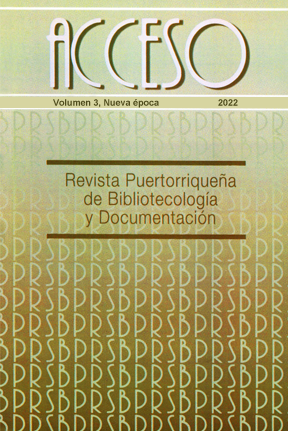Abstract
Literature tells us that resilience is an ability to recover from, or adjust easily to misfortune or change. History is replete with cases of the resilience of humans, organizations, societies, and systems. The University of Guyana Library (UGL) has endured some major floods at its current Turkeyen campus location, which have resulted in significant damages, and change in space allocations. Its survival after these disasters can be attributed to a combination of critical strategies. However, it has been recognised that for academic libraries to recover quickly and be resilient in the face of disaster it is important that there be plans and policies designed to guide risk reduction, response, and recovery. This research will document the effects of and the responses to the annual flooding that the UGL has experienced. It will also outline a proposal for the UGL as it relates to planning for flood and its effects, securing assets to avoid flood damage, and maintaining the library’s services and access to resources during flooding.
References
Amarasiri, U. (2005). Tsunami affected libraries in Sri Lanka: Rebuilding process and challenges. In Open Seminar on the Documentary Heritage Damaged by the Indian Ocean Tsunami. National Diet Library, Tokyo, Japan, December 06, 2005. http://www.ndl.go.jp/en/iflapac/pdf/amarasiri.pdf
American Library Association. (2018). NNLM Grant – Caribbean library disaster relief. http://www.ala.org/aboutala/nnlm-grant-caribbean-library-disaster-relief
Bowen, G. (2009). Document analysis as a qualitative research method. Qualitative Research Journal, 9(2), 27-40. DOI: http://dx.doi.org/10.3316/QRJ0902027
Buchanan, S. (1988). Disaster planning, preparedness and recovery for libraries and archives: A RAMP study with guidelines. http://unesdoc.unesco.org/images/0007/000798/079813eb.pdf
Cassell, G. (2004). Library experiences with natural disasters: Hurricanes and volcanoes (Montserrat). International Preservation News, 34(December), 4-11. http://archive.ifla.org/VI/4/news/ipnn34.pdf
Coghlan, D. & Brydon-Miller, M. (2014). Positionality. In D. Coghlan & M. Brydon-Miller (Eds.), The SAGE encyclopedia of action research (pp. 628-630). SAGE.
Few, R. (2003). Flooding, vulnerability and coping strategies: local responses to a global threat. Progress in Development Studies, 3(1), 43-58.
Foley, T. (2019). Pacific collections of the Australian National University library - Impacts of the Chifley flood. The Journal of Pacific History, 54(2), 268-270. https://doi.org/10.1080/00223344.2018.1559434
Given, L. (2008). The SAGE encyclopedia of qualitative research methods. SAGE. https://dx.doi.org/10.4135/9781412963909
Herr, K., & Anderson, G. (2012). What is an action research dissertation? In K. Herr & G. Anderson, The action research dissertation: A guide for students and faculty (pp. 1-7). SAGE.
IFLA. (2006). IFLA disaster preparedness and planning: A brief manual. https://repository.ifla.org/handle/123456789/1315
Lunde, D. & Smith, P. (2009). Disaster and security: Colorado State style. Library & Archival Security 22(2), 99-114. https://doi.org/10.1080/01960070902869766
Pelling, M. (1997). What determines vulnerability to floods; A case study of Georgetown, Guyana. Environment and Urbanization, 9(1), 203-226. https://doi.org/10.1177/095624789700900116
Ray, E. (2006). The Prague library floods of 2002: Crisis and experimentation. Libraries & The Cultural Record, 41(3), 381-391. http://www.jstor.org/stable/25549347
Robertson, D. (2005). SLA’s response to natural disasters. Information Outlook, 9(10), 20-26.
Robertson, G. (2014). Disaster planning for libraries: Process and guidelines. Elsevier Science & Technology.
Superio, D., Alayon, S. & Oliveros, M. (2019). Disaster management practices of academic libraries in Panay Island, Philippines: Lessons from Typhoon Haiyan. Information Development 35(1), 51-66. https://doi.org/10.1177/0266666917725905
Ugwuanyi, R., Ugwu, M., & Ezema, K. (2015). Managing disasters in university libraries in South East Nigeria: Preventive, technological and coping measures. Library Philosophy and Practice, 1289, 1-22. http://digitalcommons.unl.edu/libphilprac/1289
University of Toronto Libraries. (2022). Disaster plan for library materials. https://onesearch.library.utoronto.ca/sites/default/files/finance-admin/sep2022disasterplan.pdf
Zaveri, P. (2014). Damage to libraries due to water related disasters. Library Philosophy and Practice, 1165, 1-15. http://digitalcommons.unl.edu/libphilprac/1165
Zhou, L., Wu, X., Xu, Z. & Fujita, H. (2018). Emergency decision making for natural disasters: An overview. International Journal of Disaster Risk Reduction 27, 567-576. https://doi.org/10.1016/j.ijdrr.2017.09.037
Ziegler, A., Wasson, R., Bhardwaj, A., Sundriyal, Y., Sati, S., Juyal, N., Nautiyal, V., Srivastava, P., Gillen, J. & Saklani, U. (2014). Pilgrims, progress, and the political economy of disaster preparedness - the example of the 2013 Uttarakhand flood and Kedarnath disaster. Hydrological Processes, 28(24), 5985–5990. https://doi.org/10.1002/HYP.10349

This work is licensed under a Creative Commons Attribution-NonCommercial-NoDerivatives 4.0 International License.
Copyright (c) 2022 Simone Bernard, Rosemond Carroll

